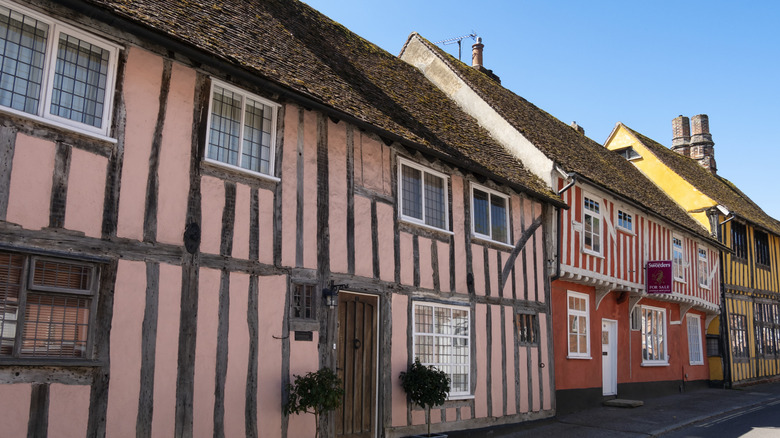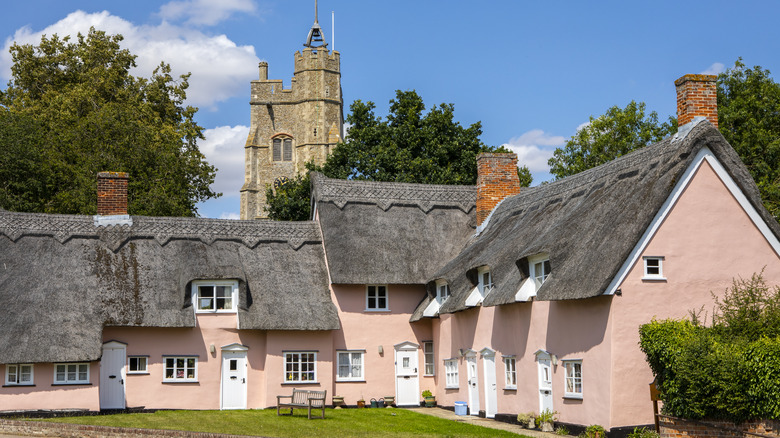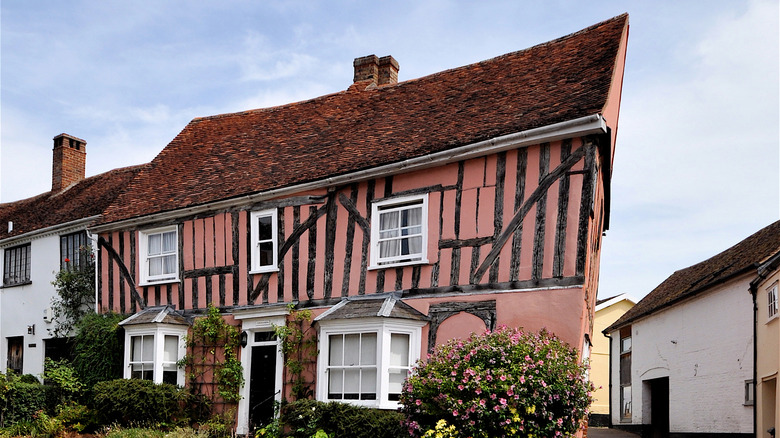The Odd Reason Houses In This Picturesque English Village Display A Unique Shade Of Pink
Marco Pierre White may be a famous Michelin-starred chef and TV personality, but he found out that celebrity was no match for tradition when he bought the Angel Hotel in Lavenham, a quaint village in the east of England. In 2013, local residents were outraged when the 15th-century building was given a facelift and a fresh lick of paint, claiming that it "lowered the tone." The chef's crime? Painting the historic pub the wrong shade of pink. The situation was defused when the district council intervened and White was forced to re-paint the property a darker hue than the "blancmange-like" shade that caused such offense.
A choice of color may seem like an odd thing for villagers to get up in arms about, but Suffolk Pink is an important part of the county's identity and it has a very unusual history. Suffolk is proud of its rural heritage and the unique shade, somewhere between salmon and rose but smokier than both, is strongly tied to local traditions dating back to the 14th century.
It's a lovely color, especially when painted on the outside of a crooked half-timbered cottage with a thatched roof, and you can see many examples if you visit the county's gorgeous villages and market towns. You might even think it would be a good color to paint your own house, but chances are you wouldn't like some of the ingredients in the original medieval recipe.
Where did Suffolk Pink come from?
Nowadays, we take it for granted that paint for our homes is mixed on a huge industrial production line somewhere. Back in the 14th century, it was a far more organic process as people added natural ingredients to standard limestone whitewash to create different colors. Historians have many theories about the exact combination that gave rise to Suffolk Pink, although most agree that common ingredients like elderberries, sloe berries, or blackthorn were used by dyers to achieve the distinctive color. Some suggest that crushed brick, burnt clay, or ironstone (a reddish sedimentary rock) were mixed in to give the paint elemental protective qualities during the superstitious medieval times. With plentiful livestock in the region, another more stomach-churning additive may have been the blood of pigs or oxen.
This technique resulted in a variety of pinks that we see today in Suffolk's villages, although the color became more standardized in the Victorian era. Suffolk Pink is still far from uniform, but there are strict limits to the exact shade you can use to paint the exterior of your house if it is a listed historical property. As Marc Pierre White found out with his decorative faux pas, doing so without permission could land you in trouble with the local authorities and the neighbors. There are even cases where people were forced by the council to paint their house Suffolk Pink to match adjacent properties!
Where can you see Suffolk Pink houses?
Houses painted Suffolk Pink are dotted all over the county, making for a charming day trip if you're staying in London. In the village of Cavendish, there is a row of pink cottages with thatched roofs called Hyde Park Corner, overlooked by the picturesque St. Mary the Virgin Church. The nearby Long Melford, once a bustling medieval town that made its wealth from the thriving cloth trade, has several nice examples along its charming High Street. For the best overall experience, however, you should head to Lavenham, one of many Harry Potter filming locations in the U.K.
Regarded as "England's finest medieval village," Lavenham was once a prosperous wool town that was ranked the 14th richest place in the country back in the 16th century. That wealth enabled traders to splash their cash on splendid houses and halls, many of which survive today: Lavenham has around 300 gorgeous listed buildings to enjoy. Pride of place is the Guildhall, one of the finest medieval timber-framed buildings in England; the appropriately-named Crooked House; and the wonderful De Vere House, a luxurious B&B that provided inspiration for Godric's Hollow in "Harry Potter and the Deathly Hallows: Part One." None of these major Lavenham landmarks are actually painted the county's signature color, but you will see plenty of Suffolk Pink as you walk the streets of this wonderful English village.


